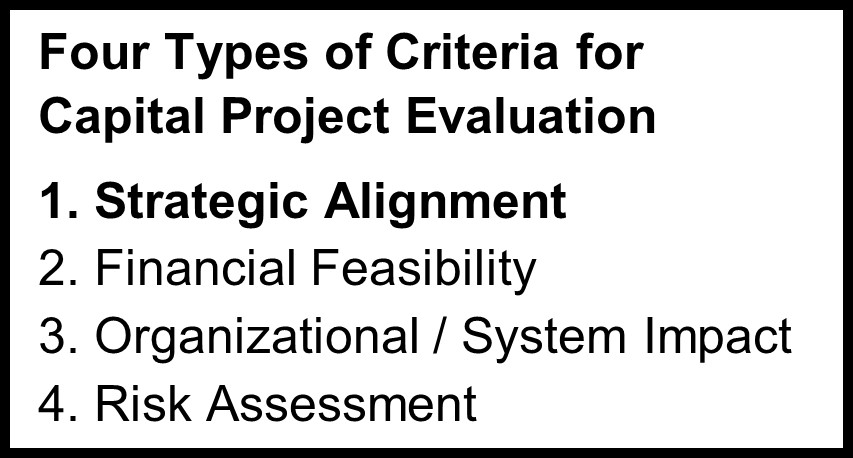Capital Part 2: Strategic Alignment
 When capital is limited and the possible investment opportunities are numerous, how can organizations select the “best” ones for funding?
When capital is limited and the possible investment opportunities are numerous, how can organizations select the “best” ones for funding?
This is the current environment for most health and human service organizations. The starting point might seem obvious – apply selection criteria and see which projects “score” the best! With tight capital and lower margins, short-term financial impact is an obvious important criterion. And, with little room for failure, another might have more to do with more with likelihood to succeed, especially in the long run.
Four types of criteria (see sidebar) when taken as a group, help us in both ways.  One includes important aspects of financial feasibility, while the other three add other considerations that reflect how the role of health care (and health care providers) is evolving. This broader definition of success mirrors the broader definition posed by concepts like the Balanced Scorecard and the Quadruple Aim.
One includes important aspects of financial feasibility, while the other three add other considerations that reflect how the role of health care (and health care providers) is evolving. This broader definition of success mirrors the broader definition posed by concepts like the Balanced Scorecard and the Quadruple Aim.
Let’s explore the first one, Strategic Alignment, in more detail. The best projects make sense strategically, and the following five elements are particularly important in the era of tight capital. The first two are well established ways to evaluate strategic alignment, while the remaining three reflect more recently developed points of strategic focus:
- Fit with Vision / Goals: Preference would always be given to projects that have a clear, direct fit with the organization Vision and at least one of the Goals or Objectives. Projects that will help enable multiple Goals or Objectives deserve even more consideration.
- Leverage Industry Trends: Since sound strategy should be influenced by developments in the broader industry, the best projects are those that leverage one or more industry trends, respond to one or more industry issues, or adapt one or more emerging industry best practices.
- Community Benefit / Market Need: Sound strategy is also derived from a thorough market assessment. The best projects are those that would address one or more high priority needs identified in the Community Health Needs Assessment (CHNA), and even better, be instrumental in implementing one or more recommendations in the Community Health Improvement Plan (CHIP).
- Customer Satisfaction: Capital projects that related to one or more Key Quality Characteristics (the dimensions of quality deemed most important by your customers) should receive extra consideration. Customer satisfaction is critical to patient loyalty (driving volume) and engagement (driving outcomes and referrals).
- Health Equity Impact: The Covid19 Pandemic highlighted growing disparities in care access and health. Increasingly highlighted in thorough CHNAs, the best capital investments will address health inequity at some level.
Are you and your leadership team prepared to get the most out of your capital investments? Let us know if you have any additional thoughts as this series unfolds, or if we can be of any help applying these ideas in your capital project review, selection, and implementation processes.
Roberta Jelinek and Jeff Schilling
(This is the 2nd of 7 posts in the series. For the full article, contact either one of us.)

Trackbacks & Pingbacks
[…] criteria for selecting the best projects to fund. Some elements of that first criterion, Strategic Alignment, are well established, while others add new perspective to reflect where health care is heading. […]
Leave a Reply
Want to join the discussion?Feel free to contribute!